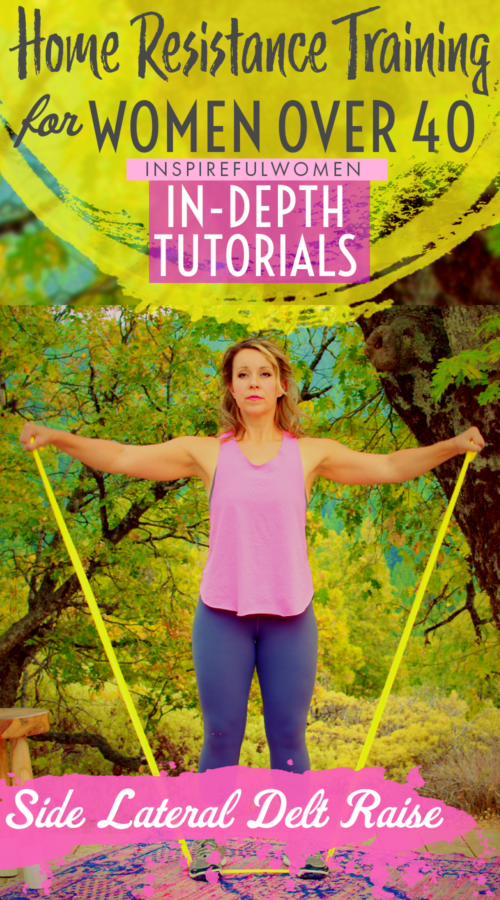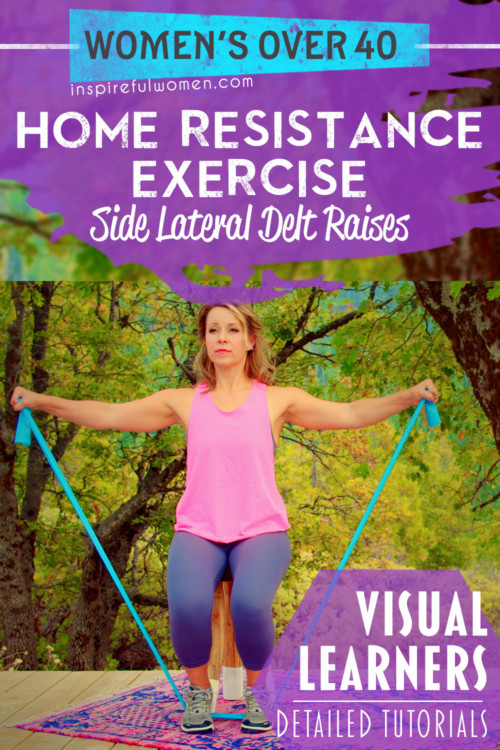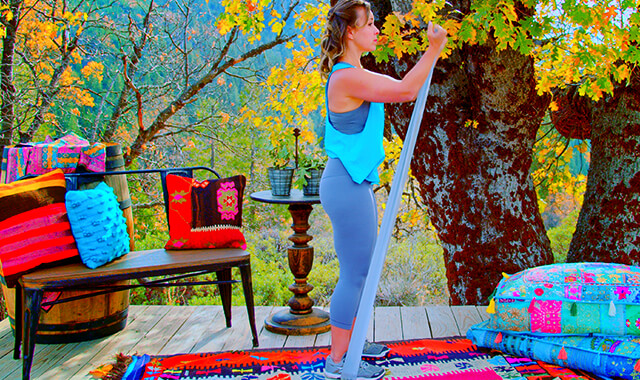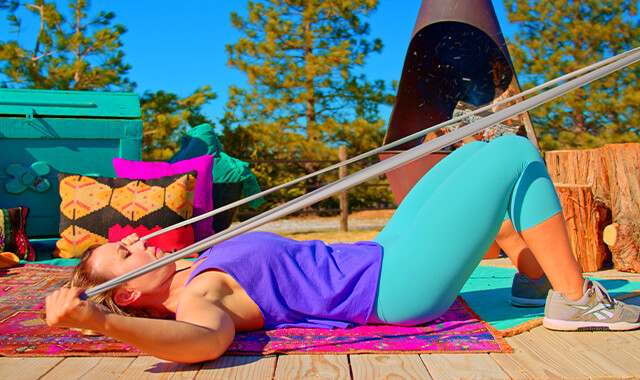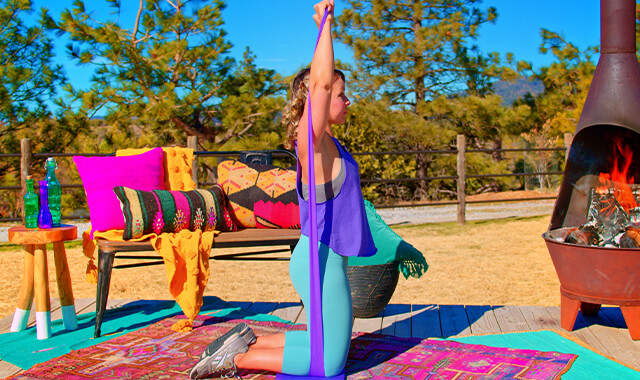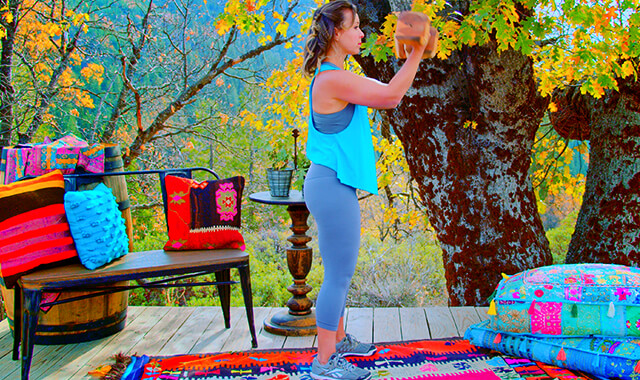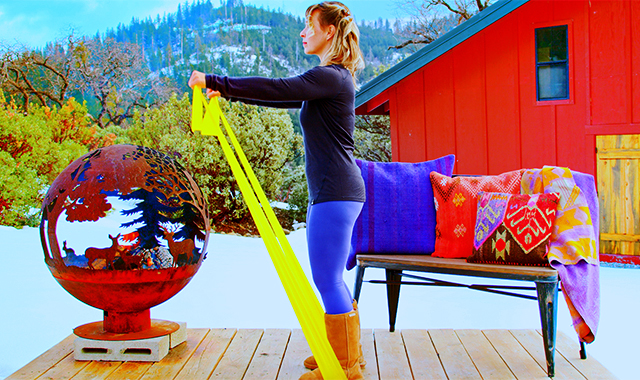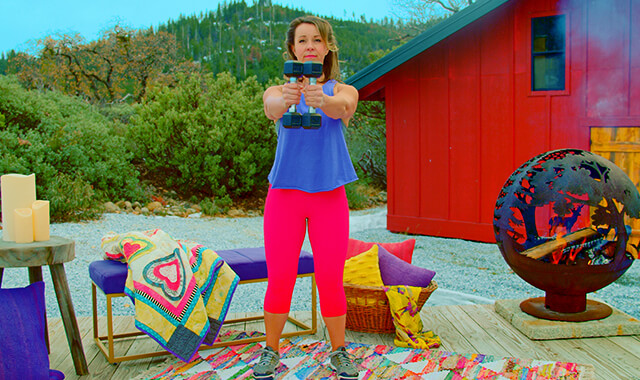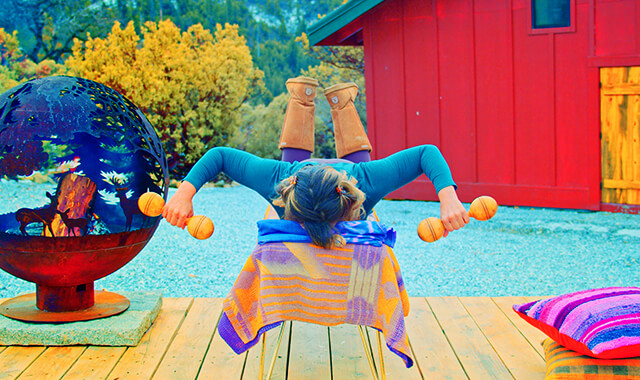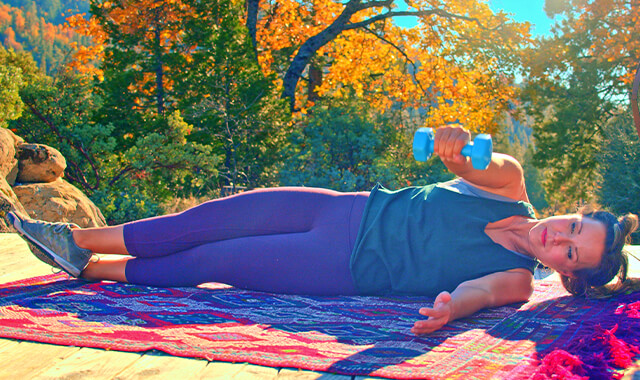Dumbbell Lateral Delt Raises
How to Do Standing Lateral Delt Raises - Dumbbell or Band | In-Depth Guide [VISUAL LEARNERS] Beginner
Proper Form, Common Mistakes, Variations + Easier & Harder | Home Resistance Training
WHAT DO YOU WANT TO SEE?
QUICK DEMO
QUICK DEMO
WHAT WE'RE DOING TODAY
WHAT & WHY
BENEFITS OF TRAINING YOUR LATERAL DELTOID MUSCLE
WHAT
WHAT WE'RE DOING TODAY
Improve your posture, flexibility, and strength in this lateral delt raise exercise. This exercise movement is nice and simple! I love simple stuff - I feel like taking a nap when a movement has 6 different steps and my body parts moving all the over place don't you? I mean I'll do them, it's just...so nice to have a break and do something easy!
ALL WE'RE DOING IS:
MOVING OUR ARMS AWAY FROM OUR BODY OUT TO OUR SIDES.
Like you're pretending to take flight. :)- That's it! The movemement involves only 1 joint in one direction.
We are hitting the side of our shoulder muscle today folks!
Main shoulder muscle = Deltoid.
Side portion of that muscle = Lateral Delt.
Why we're bothering to "hit" it in a minute.
The side lateral deltoid raise exercises focuses on working the middle (or lateral) portion of the deltoid and the supraspinatus (one muscle of the rotator cuff), with little input from the other parts of the deltoid muscle. There aren’t really a ton of exercises that target this muscle very well, so this is one of the really great core movements to use for training this muscle.
KEY TIP is to only raise the arms to shoulder height, no higher, to protect the health of your shoulders.
WHY BOTHER DOING IT?
WHY
WHY DO WE EVEN CARE?
The lateral delt, which remember is just a fancy word to say the side of your shoulder muscle, is used daily for activities that have to do with carrying items out to our sides or raising items out to our sides.
KEEP MUSCLES BALANCED IN RELATION TO EACH OTHER
All 3 parts of the shoulder muscle- the front, side, and back of the deltoid (which are called the anterior, lateral & posterior parts of the delt) work together to move and support the shoulder joint. It is important to include exercises that target each one of these portions of the muscle to keep all portions of the muscle balanced.
Many people only include exercises that work the front of the deltoid muscle, creating an imbalance which can pull the upper arm forward.
HELP RECTIFY IMBALANCE CAUSED BY DAILY MODERN LIFE
Another thing that can contribute to an imbalance is that much of our daily activities are done in front of our bodies, like working on a computer, writing, eating, driving, and reading. This can result in a rounded shoulder posture, and it can interfere with how the shoulder joint moves. Doing lateral raises will help to balance this out by increasing the strength of the side delt.
EFFECTIVE EXERCISE FOR THIS MUSCLE
Effective training for the lateral deltoid involves lifting your arm out to the side, away from the body. The lateral deltoid raise is exactly that. The exercise targets the lateral deltoid and supraspinatus by keeping the torso stable while lifting the arm out to the side. The addition of a weight serves two purposes, it pulls the arm down in the shoulder socket (the lateral deltoid and supraspinatus will work to hold the upper arm bone up in the socket), and it works the muscles as the arm is lifted up out to the side of the body.
A well designed exercise program will include exercises that target each portion of the deltoid muscle. If one part of the deltoid is not strong enough, it can cause improper movement of the shoulder joint, which over time can cause damage.
MUSCLES THIS WORKS
MUSCLES
MAIN MUSCLES WORKED IN SIDE LATERAL DELT RAISES
LATERAL DELTOID
OTHER MUSCLES WORKED:
- ROTATOR CUFF MUSCLE (Supraspinatus)
EVERYDAY LIFE
EVERYDAY LIFE &
MUSCLE FUNCTION
HOW WE USE OUR LATERAL DELTOID IN EVERYDAY LIFE
1.LIFTING ARMS STRAIGHT OUT TO YOUR SIDES
This is called abduction & nope, it doesn't involve your arms being abducted by aliens, good thing wheww. Think about how many movements we do throughout the week, I mean even throughout the DAY that involve our arms moving out to the sides or holding them out to the sides of us in some way, which is it's main function:
- Dressing
- Washing, drying your hair
- Brushing teeth
- Pulling up socks or pants
- Carrying kids on your hip
- Lots of stuff with kids
2. STABILIZING YOUR SHOULDER JOINT
Pulls upward on our upper arm bone (humerus) against downward pulls. This helps ensure the bone stays in the right place on the body so the joint doesn't get damaged.
- Carrying heavy items down at your side like:
- Multiple bags of groceries anyone?
- Buckets
- Luggage (you should stop doing that and get one with rollers btw)
QUICK NOTE: The lateral deltoid is not actually it's own muscle - it's 1 part of a larger muscle (just "the deltoid") that has 3 main parts. I needed to clarify that or Carol the PT I work with will probably kill me. Just kidding, she's way too nice to do that.
HOW TO DO THE EXERCISE
LOOKS
HOW SIDE LATERAL DELT RAISES SHAPE OUR BODY
The exercise will tone and build the muscles of the top of the shoulder and the arm. It adds to that capped shoulder look.
When you train the shoulder muscles, it helps make the waist look smaller as well.
I personally love the capped shoulder look, so it’s something I have made a mainstay of my routine.
PROPER FORM
HOW TO DO SIDE LATERAL DELT RAISES
EQUIPMENT, SETS & REPS
EQUIPMENT
Main set (3: Light/Med/Heavy)
X-Heavy Band (I recommend getting this too if you plan to use resistance bands frequently).
SUGGESTED STARTING WEIGHT FOR WOMEN:
Low resistance to begin - 1-3 pounds, resistance bands level #2 or 3 (green or orange in some brands).
1-3 lbs options: a couple cans of food, or fractional weights are awesome because you can stack them to create all sorts of weight combinations between a ½ lb 2 lbs. 2.5 lb plates
4-10 lb options- here we’ll just stick with dumbbells. It can take quite awhile to be able to increase the weight- and when you go up, you will most likely have to do less reps for awhile. One other technique I might use is to do as many as I can (say 7-10) with the heavier weight I’m trying to do, then switch over to the lighter set to finish off the rest of the reps.
Household items such as cans, water bottles or other jugs work well as weights. The water bottles are nice if filled with water because the movement of the water will challenge the stability of the shoulder joint and result in more rotator cuff activation.
SETS & REPS:
2-3 Sets, 8-10 Reps
PACE:
Slow and controlled movement. The muscles of the deltoid are a combination of slow and fast-twitch. They act as prime movers but also help stabilize the shoulder joint. Moving your arms downward (the eccentric portion of the movement) is equally important to the lift portion of the exercise. The two parts of the exercise work the muscles differently. Always feel that you are lifting and lowering your arms in a purposeful manner; not lifting and dropping.
BODY POSITION
BODY POSITION FOR STANDING LATERAL DELTOID RAISES
FEET: Your feet should be shoulder width apart with the toes pointed forward.
BODY STANCE: Standing upright or slightly bent, keeping knees loose/slightly bent to provide a stable base to work off of. Back neutral, core muscles gently activated by drawing your belly button in towards your spine. No gripping the core muscles just a gentle activation to provide a stable base to work off of.
HAND/GRIP: Palms facing your thighs, wrist neutral. Your grip on the weights should be controlled but loose.
ARMS: Arms can be mostly straight (but always with a slight bend at elbow still) or a little more bent.
NECK: Keep your neck in a neutral position, the bottom of your chin should be parallel to the floor. Make sure that your neck muscles are not trying to help you lift your arm. Keep them relaxed throughout the exercise.
HOW TO DO
HOW TO DO STANDING SIDE DELT RAISES
CUE: Keep your back still and feel your arm lift upward in the shoulder socket.
Start by elongating your neck, broadening your chest, and sliding your shoulder blades down your back.
As you move your arms to shoulder height think of:
Stretching your arms AWAY from your body as you lift your arms, this will help ensure you are really targeting the middle delt and less other muscles. The movement is like making a snow angel but Do Not lift hands higher than your shoulders. Avoid lifting into pain.
As you move your arms back down to your sides think of:
Moving your arms downward in a controlled way, not letting them drop down. This eccentric portion of the movement is equally important to the lift portion of the exercise.
HOW TO SAFELY GET OUT OF THE EXERCISE
If the weight is heavy, bend your elbows and use your biceps to place the weight back down.
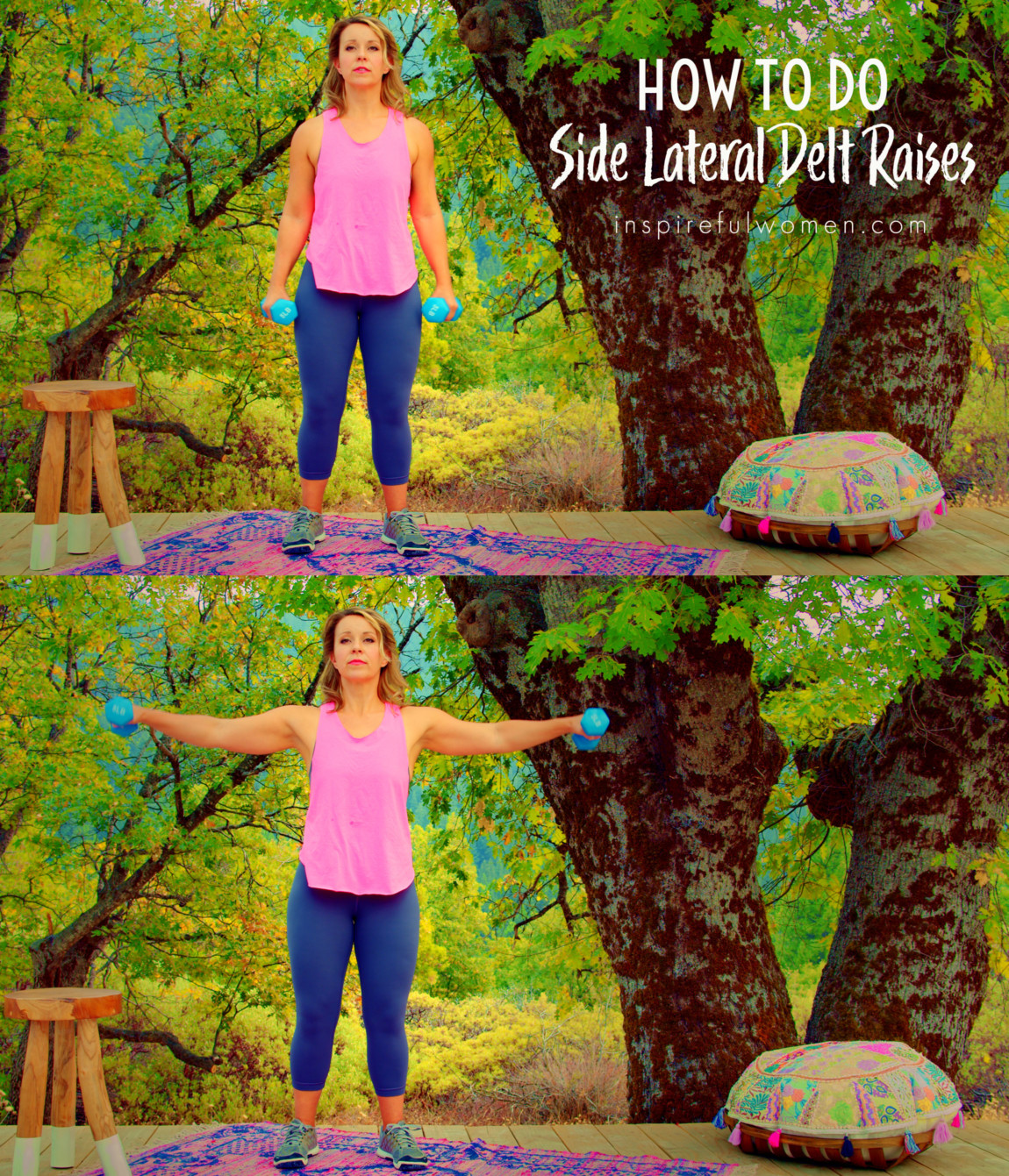
COMMON MISTAKES
COMMON MISTAKES
WHAT TO AVOID WITH STANDING LATERAL DELT RAISES
KEY TIP:
Guess what? Good news! Many avoids are the same for most movements. Once you learn the basics, there's really only a few extra avoids for each individual movement.
1. Avoid Lifting Hands Higher Than Your Shoulder
Lift your arms to shoulder height only, parallel with the ground - this helps avoid shoulder impingement. Higher is not better here. Once you lift higher than 90 degrees, it starts closing down the space in the front of your shoulder joint that over time (or at least at our age ladies) can cause us some issues and irritation of tissues and tendon. PLUS, once you pass 90 degrees of abduction, the lateral delt will not be working as hard anyway! So it's really pointless.
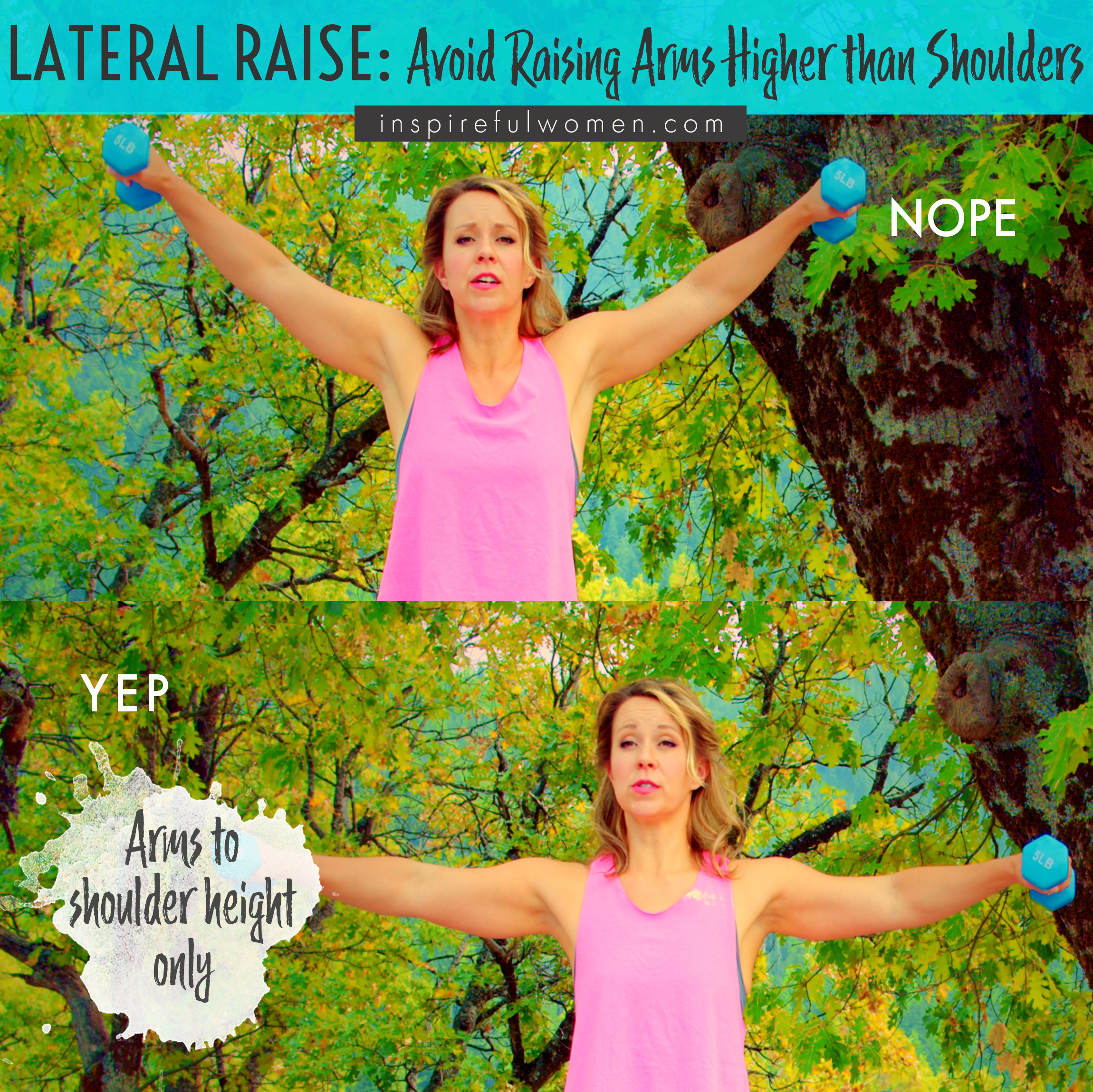
2. Avoid bringing shoulders up towards ears
Keep shoulders pressed down - if you let your shoulders ride/hunch up, this will activate your upper traps (trapezius) and compress the vertebrae in your neck. Your upper trapezius is located on either side of your neck, where your bra straps would usually sit. These muscles can get too involved in LOTS of movements and lead to excessive muscle growth here that most of women don't really want, AND also cause tension in our shoulders and neck.
So the key is just, as you lift the arms, make sure that you are keeping your shoulders in place.
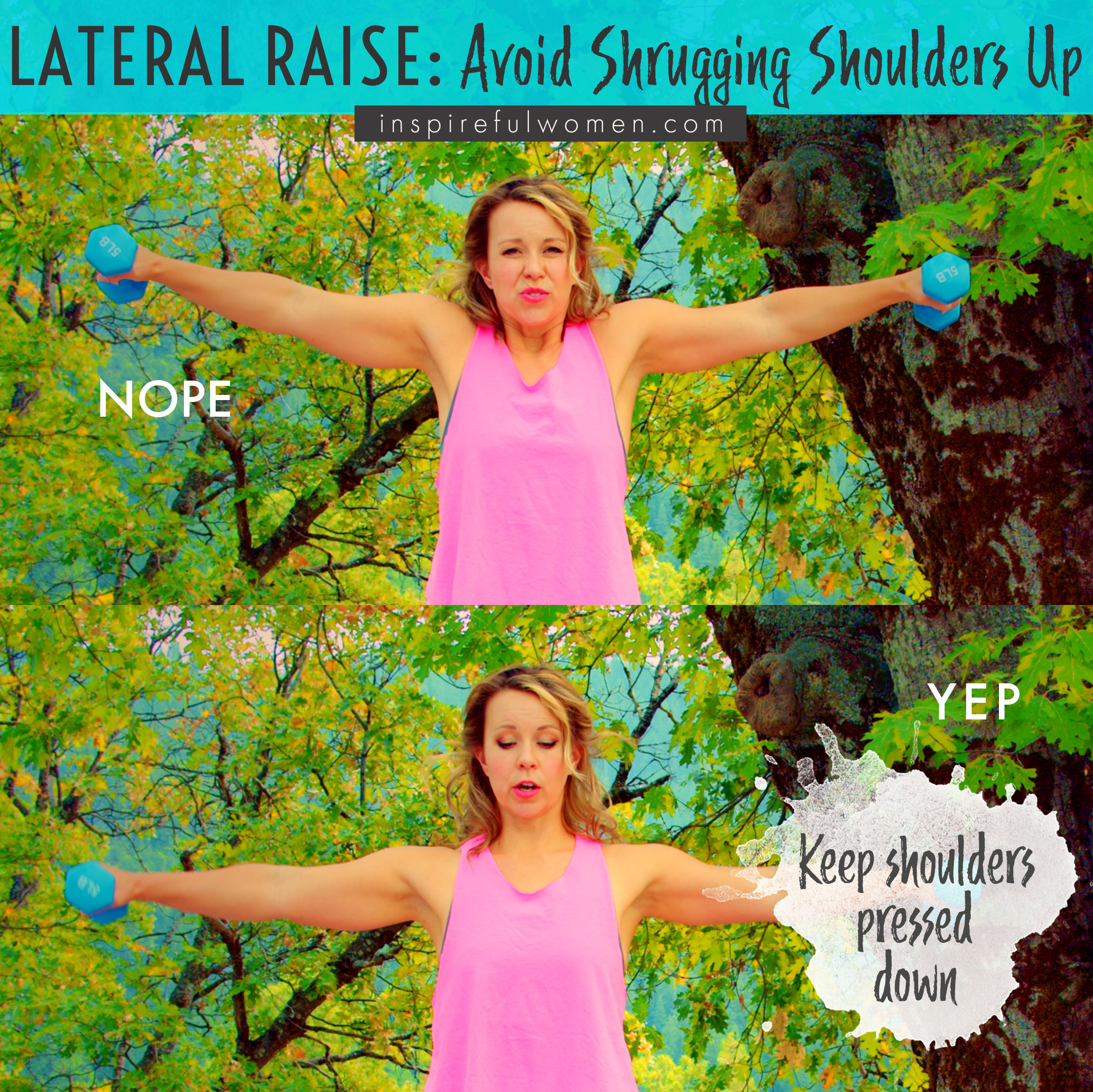
3. Avoid bending your wrist forward or backward
Avoid bending your wrist forward or backward - when we move the wrist repetitively when we're lifting weight like this, it can irritate the wrist over time.
Instead, think about keeping the wrist in line with the forearm, like it's all one piece, and the only part of our body that's causing the movement is the movement at the shoulder joint.
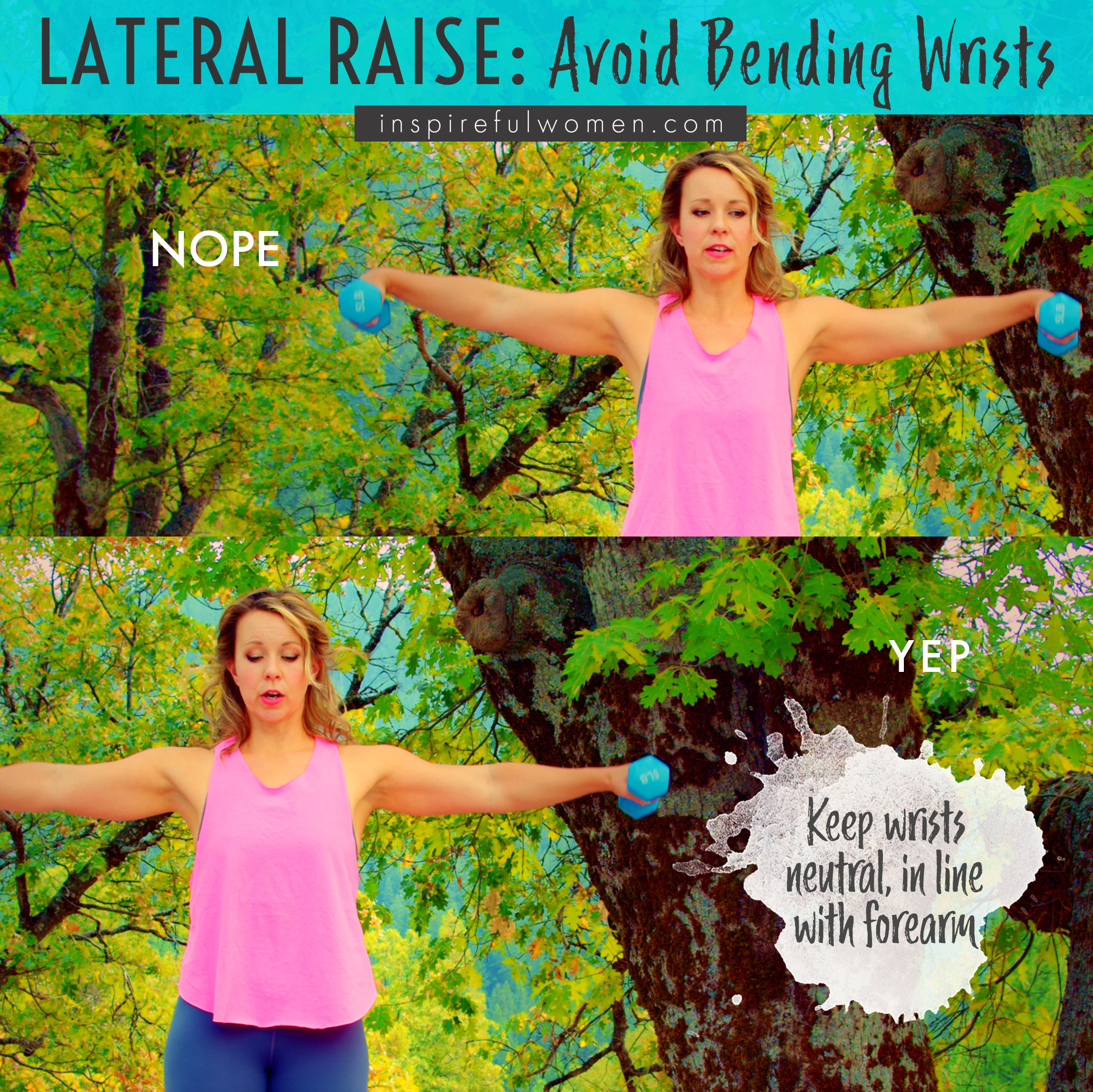
4. Avoid letting your trunk move when your arm moves
Avoid letting your torso move when your arm moves. We might find ourselves arching our spine as we lift the weight, especially as the weight gets heavier. Moving through the spine like this under load isn't desirable.
Instead think about keeping your torso nice and still, with gently engaged abs, and moving only from the shoulder. Think about your torso's job is to keep you still and stable while you are moving your arms.
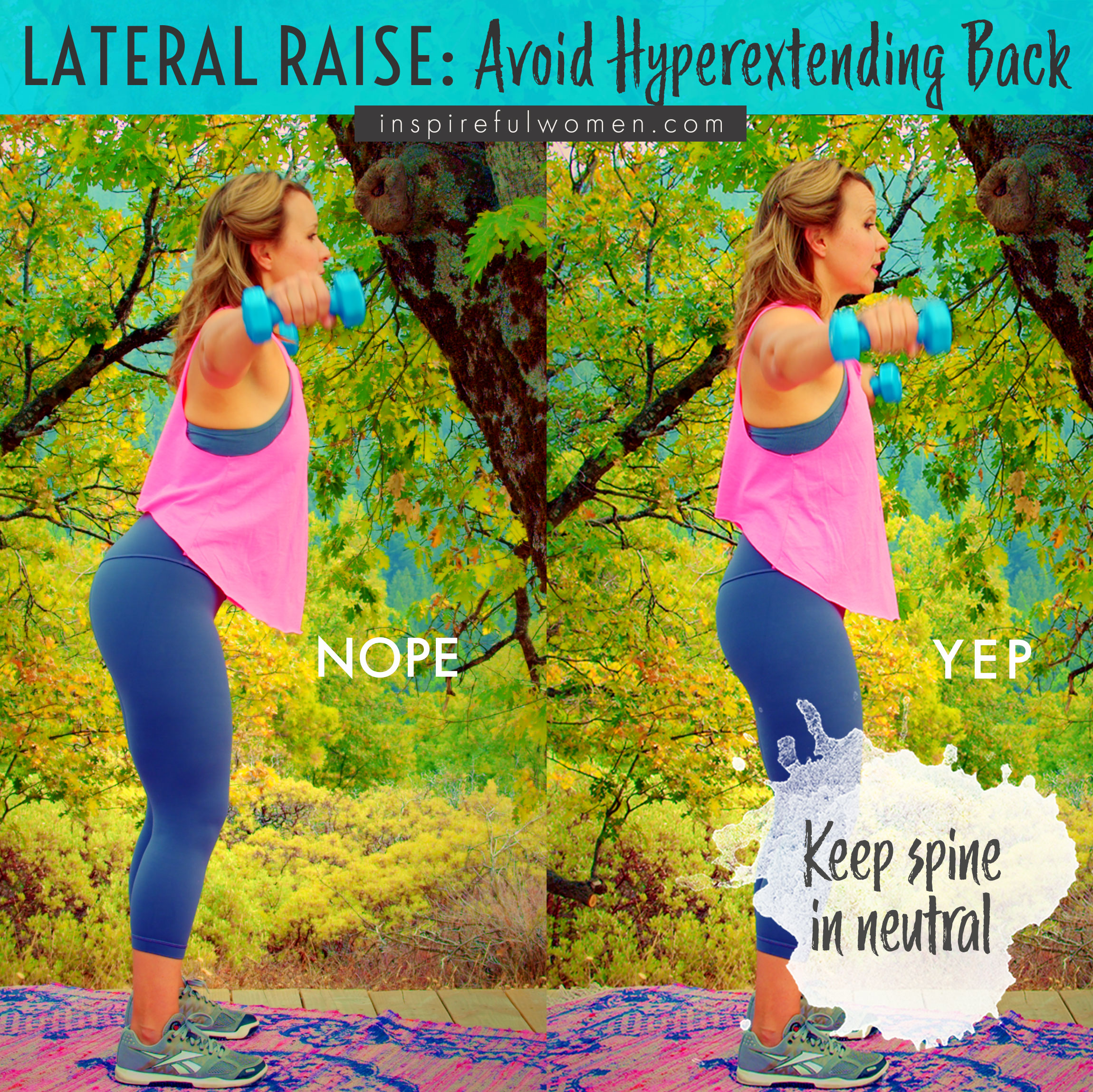
5. Avoid tightening your neck muscles
It took me AWHILE to stop doing this. I still catch myself, but thankfully it's not an actual bad habit like it was for like....years.
Why do we find ourselves tensing our neck during exercise? It's our bodies' subconscious attempt to "help" us achieve the movement. But really we want to keep our neck totally relaxed and uninvolved in the movement. I know, easier said than done, but it starts with noticing if you're doing it! Once you do, you can then work actively to relax that part of the body. I find that leaving my mouth partially open while I do my set helps me to keep my neck relaxed.
VARIATIONS
VARIATIONS
VARIATIONS OF STANDING SIDE LATERAL DELT RAISES
TORSO TALL OR BENT OVER
Torso tall or bent over
1. Upright Torso (Option 1): You can do the lateral raise with an upright torso. This would be the easiest way to do the movement in, because it requires less work for the core muscles to hold you in this position.
2. Bent Over Torso (Option 2): By hinging at the hips, you can also lean your torso over a bit. Probably no more than 30-40 degrees, otherwise you may be getting more rear delt muscle activation at that point. The advantage to this position is it will be working you core muscles more, especially your back extensor muscles, the muscles that prevent your back from rounding as they resist the pull of gravity in that bent over position. In addition, the muscles on your whole backside of the legs will be working isometrically to resist you falling forward as well.
Always keep knees soft/slightly bent either way.
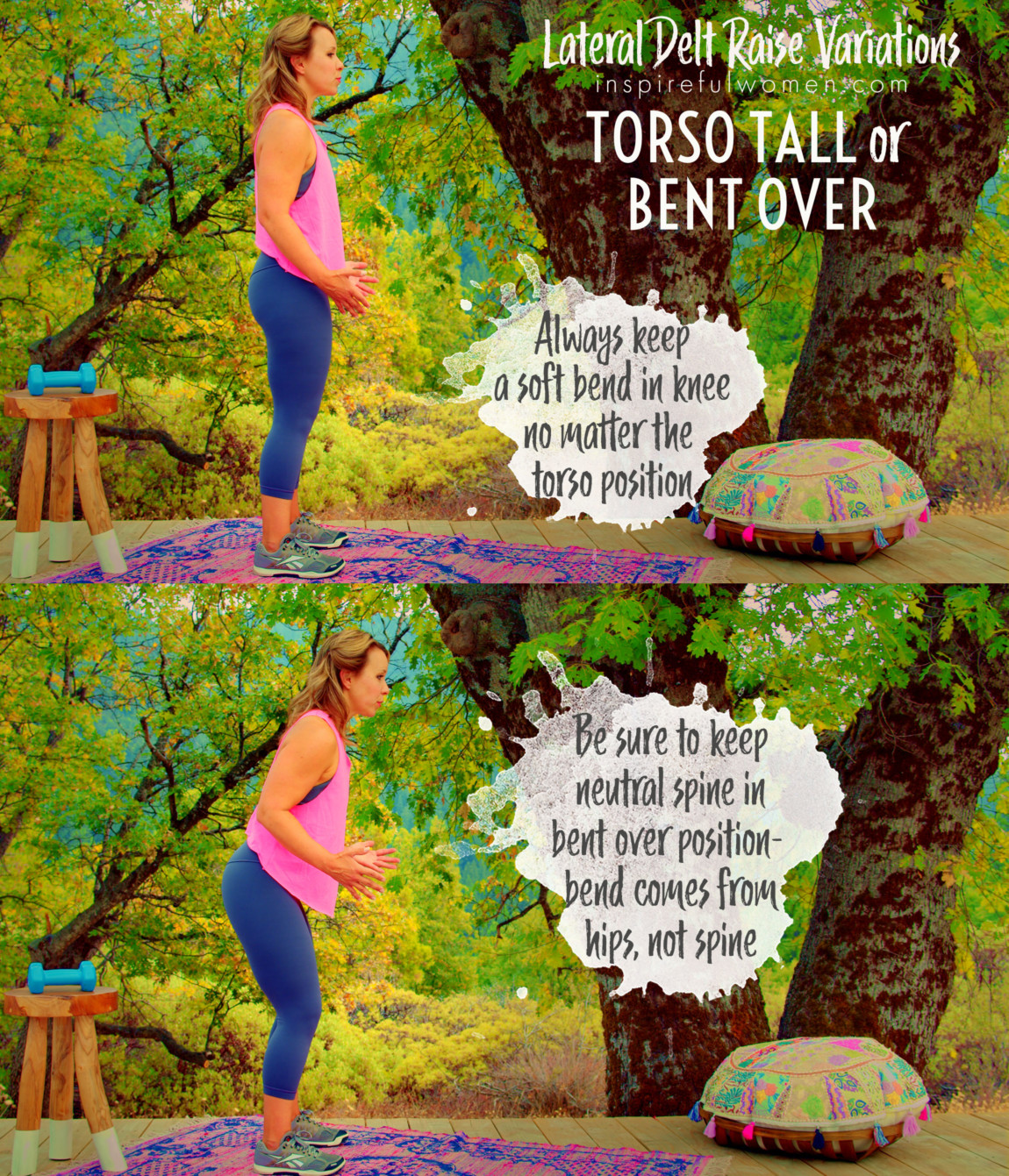
ARMS ANGLED IN 30 DEGREES
Angled Arms
The arms do not need to be directly out to the side. In fact, some may find that position painful.
Slightly angled in, about 30 degrees from directly out to your sides, will also work the lateral delts still, while positioning your shoulders in a more functional position (that is also considered safer for the shoulder joint as well).
This angle is what's called the scapular plane - when I first heard that term I assumed it's meaning was far too complex for me to understand without signing up at my community college for an anatomy class first, but guess what? It's not that bad.
It turns out that the scapular plane is just the angle that our shoulder blades lay on our ribcage back there. - it's about 30 degrees. And because of how our shoulder blades lay on our body, it's just more natural that when we extend our arms out, that it might be more in that area rather than SO directly out to our sides.
If you hold your palms at your armpits, and then slid your arms outwards at an angle, as if you are going to give me a really really big hug, that's about right!

thumbs up
Thumbs Up
Positioning your palms so that your thumbs are pointing up is often more comfortable and will decrease the risk of shoulder impingement as well.
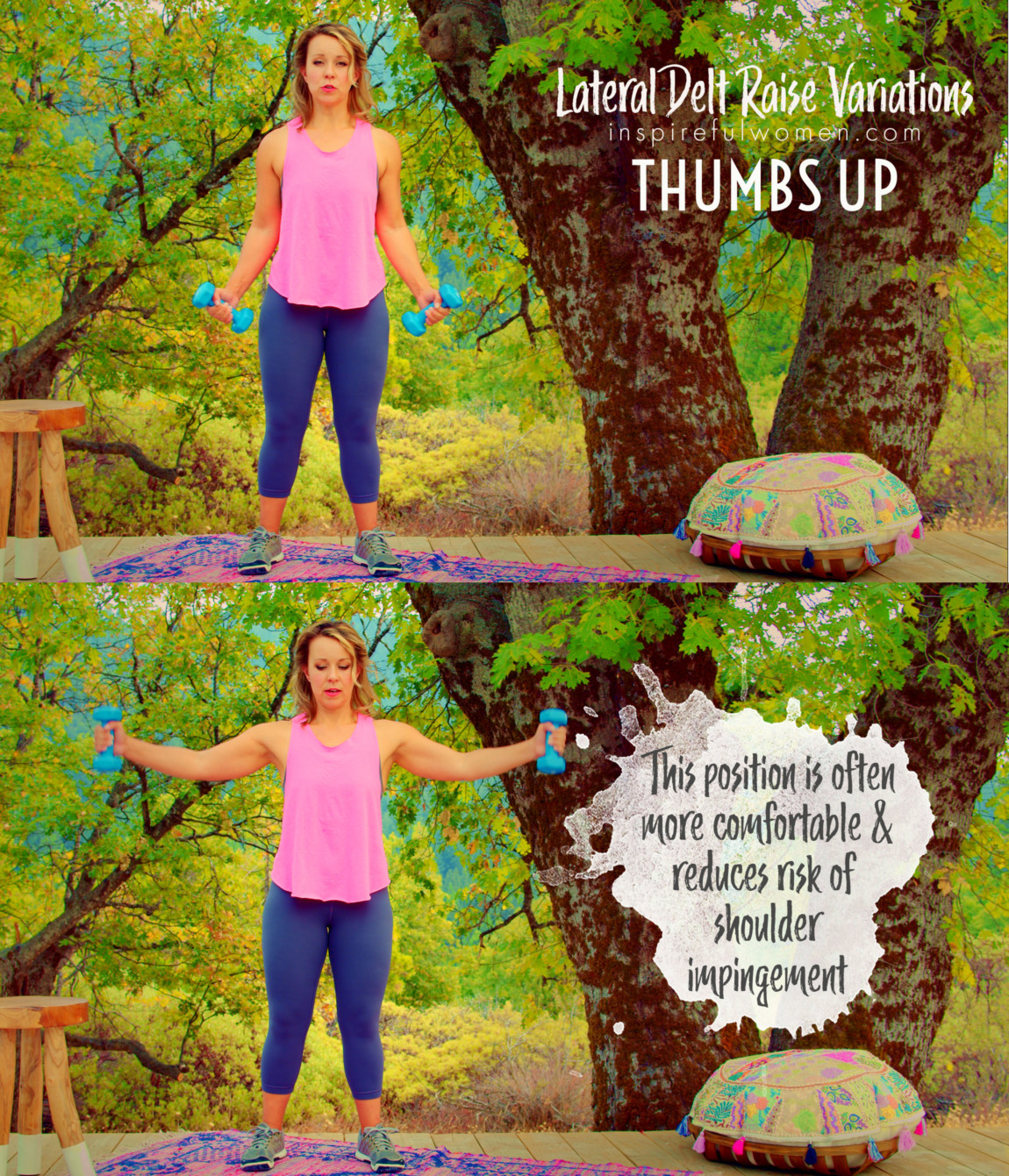
FRONT SHOULDER FOCUS
Anterior Deltoid Activation
The position of the arms will determine which portion of the deltoid muscle is targeted.
This variation basically moves us away from working the lateral delt as much. But hey, it's fun to know your options right!
Moving the arm forward a bit and internally rotating the arm in the socket (thumb down) will result in more activation of the anterior fibers (front deltoid)
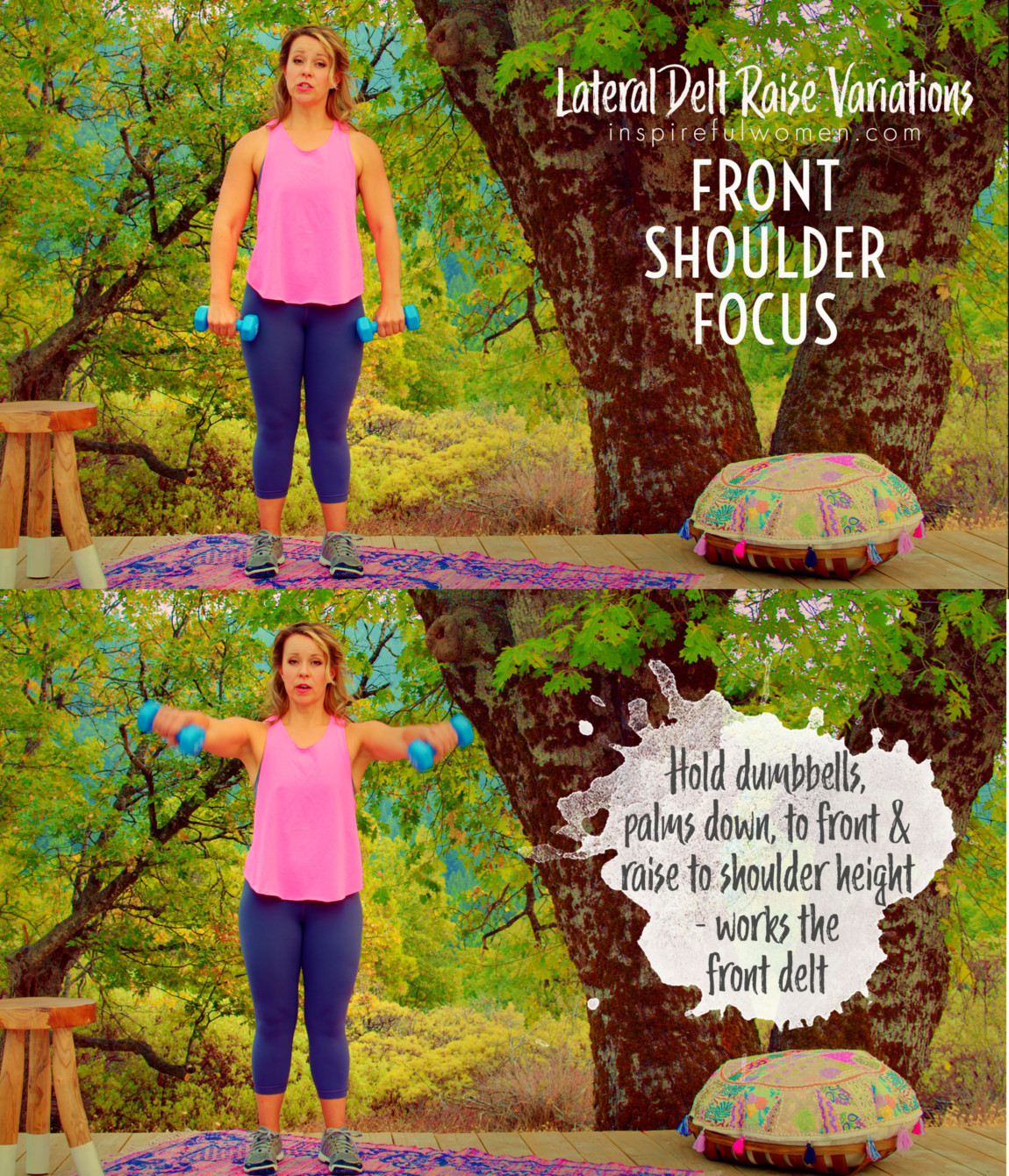
BACK OF SHOULDER FOCUS
Posterior Delt Activation
Moving the arm slightly backward and externally rotating the arm in the socket (thumb up) will result in more activation of the posterior fibers (rear deltoid).
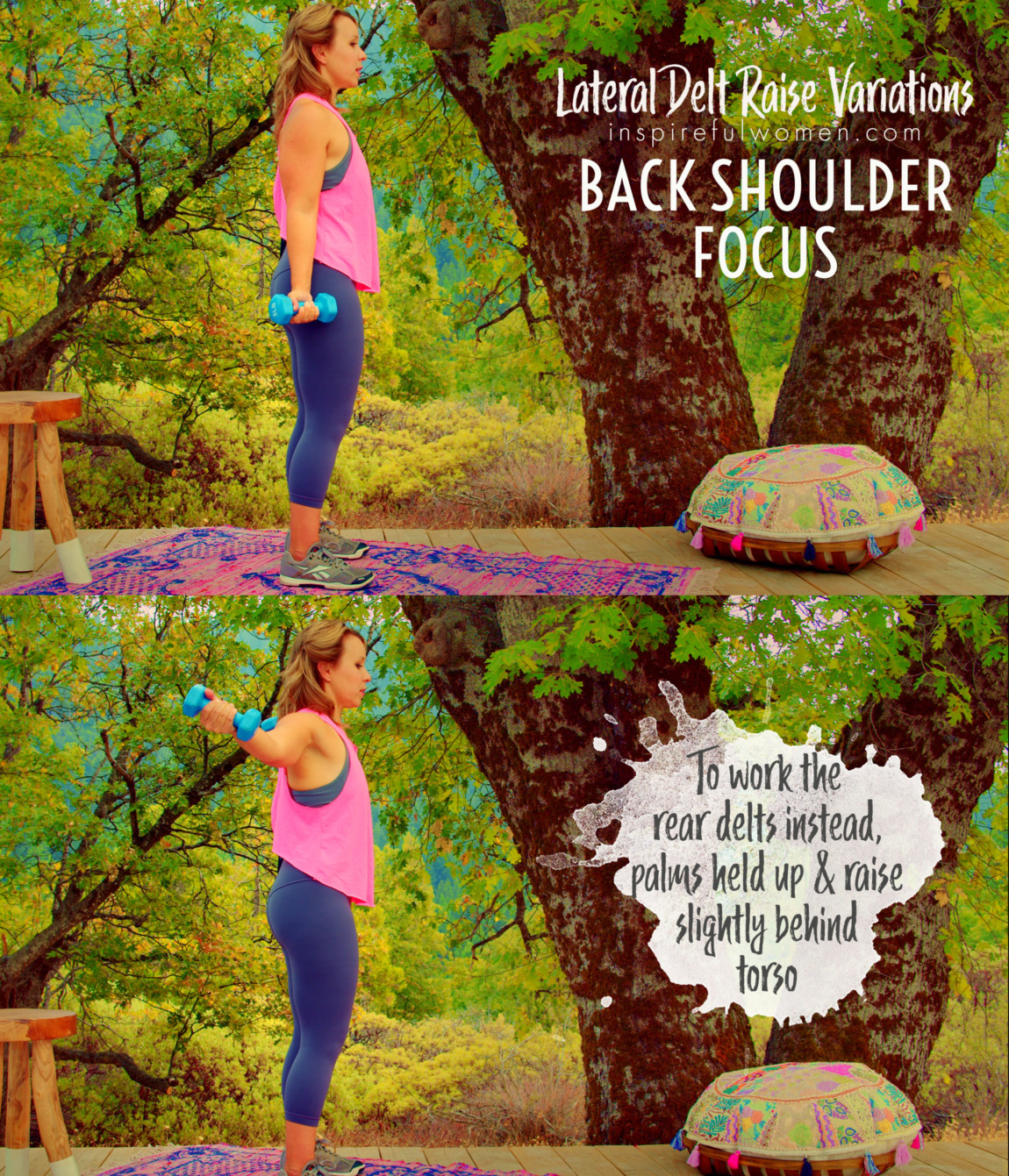
LEANING LATERAL RAISE
Single Arm Leaning Lateral Raise
You can do a lateral raise leaning the body out to the side of the working arm. The advantage of this is you in this position the supraspinatus (the rotator cuff muscle that helps the lateral deltoid lift the arm out to the side is put into a position where it does not help as much.
The supraspinatus works the most in the beginning part of lifting your arm out to the side. The leaning position puts the arm in a slightly abducted position - so basically, it removes the beginning part of lifting the arm out to the side. This means that the lateral deltoid will be doing the lifting without any help from the supraspinatus rotator cuff muscle.
Leaning the body out at an angle (towards the side of the working arm) keeps the lateral deltoid muscle under tension in throughout the entire rep.
Because the arm movement will begin from an abducted position (hanging down away from the body), the supraspinatus will be less active and the middle deltoid will be more active – the supraspinatus contributes most from 0-60 degrees of abduction, after that the deltoid does most of the work. The lateral deltoid will be under some tension throughout the movement so it will be easier to fatigue it.
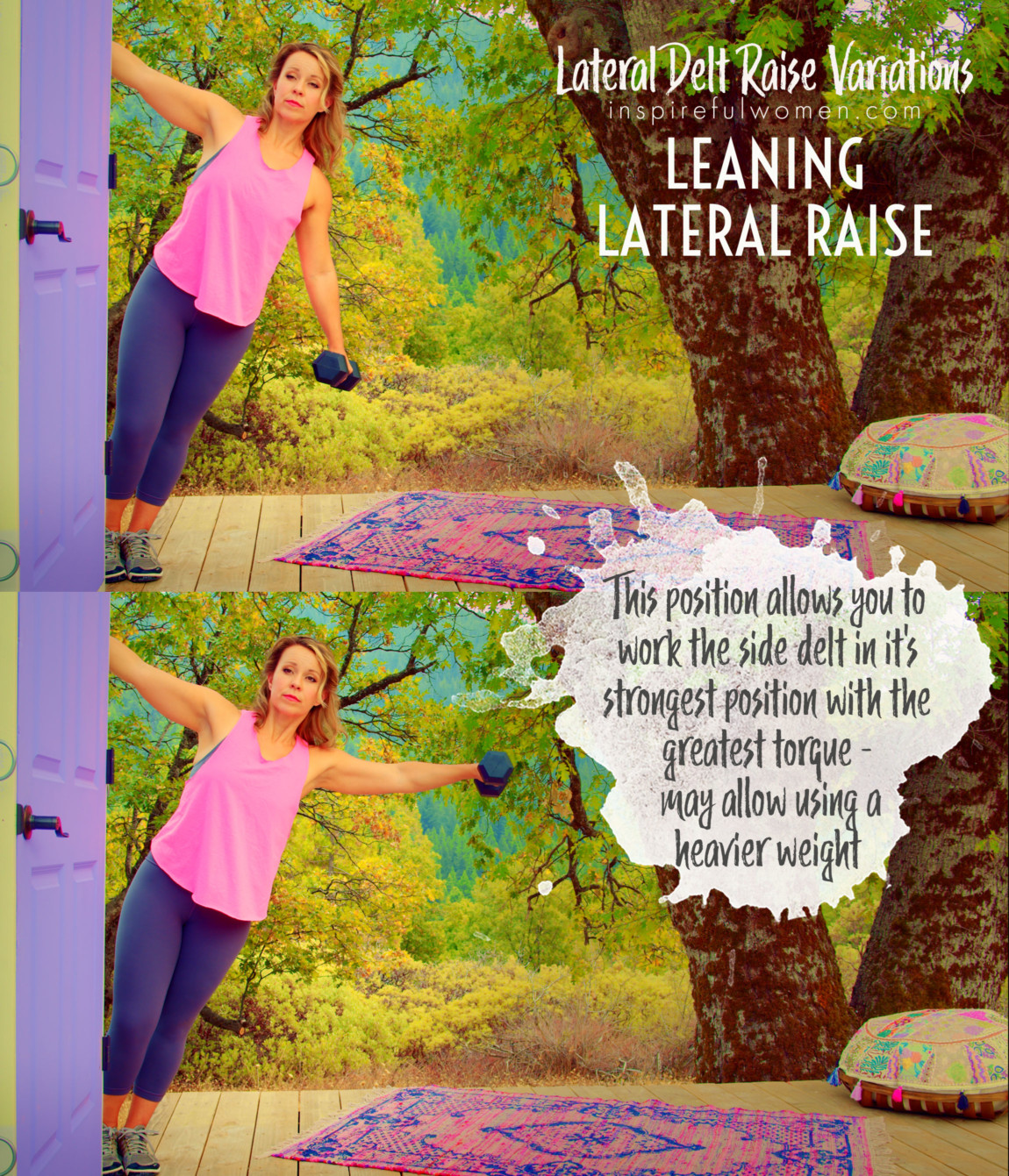
STAND ON ONE FOOT
Single Leg Lateral Raise
This will increase total muscle activation of the back and abdominal muscles. Remember to keep your hips level, so don’t drop the pelvis of the bent leg.


BANDED LATERAL RAISE
Resistance Band Lateral Raise
Stand with the feet on the bands and wrap the ends of the bands around both hands, keeping grip on the bands controlled but loose; avoid having a tight grip.
The length of the band can be adjusted to increase or decrease the resistance.
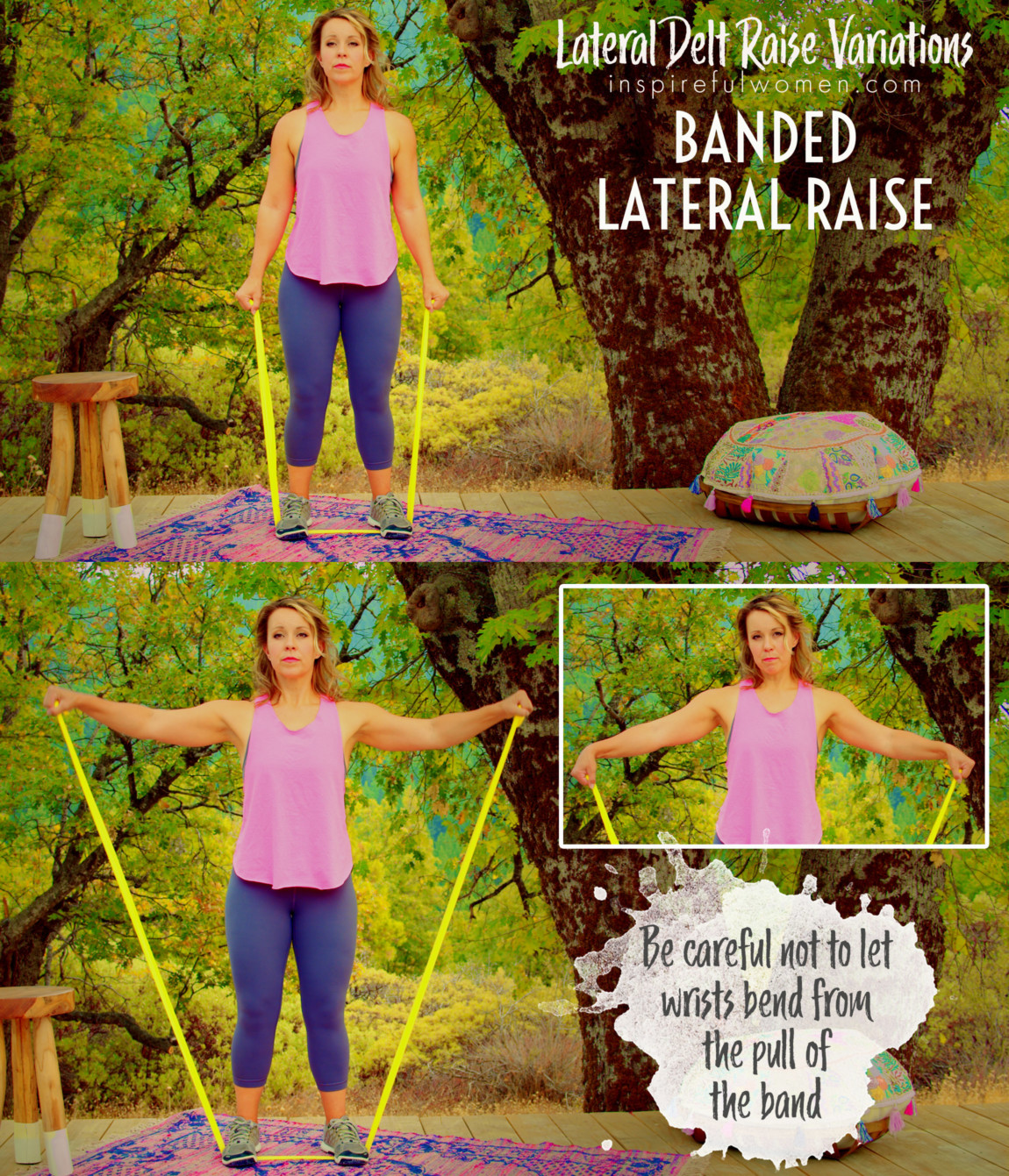
SINGLE LEG BANDED LATERAL RAISE
1 Leg Resistance Band Lateral Raise
Stand on one foot - this will facilitate activation of the lower leg, hip, lumbar, and abdominal stabilizing muscles.
Make sure to keep your knee slightly bent.
Try standing on the left foot and the right foot while using both arm, left arm and right arm.
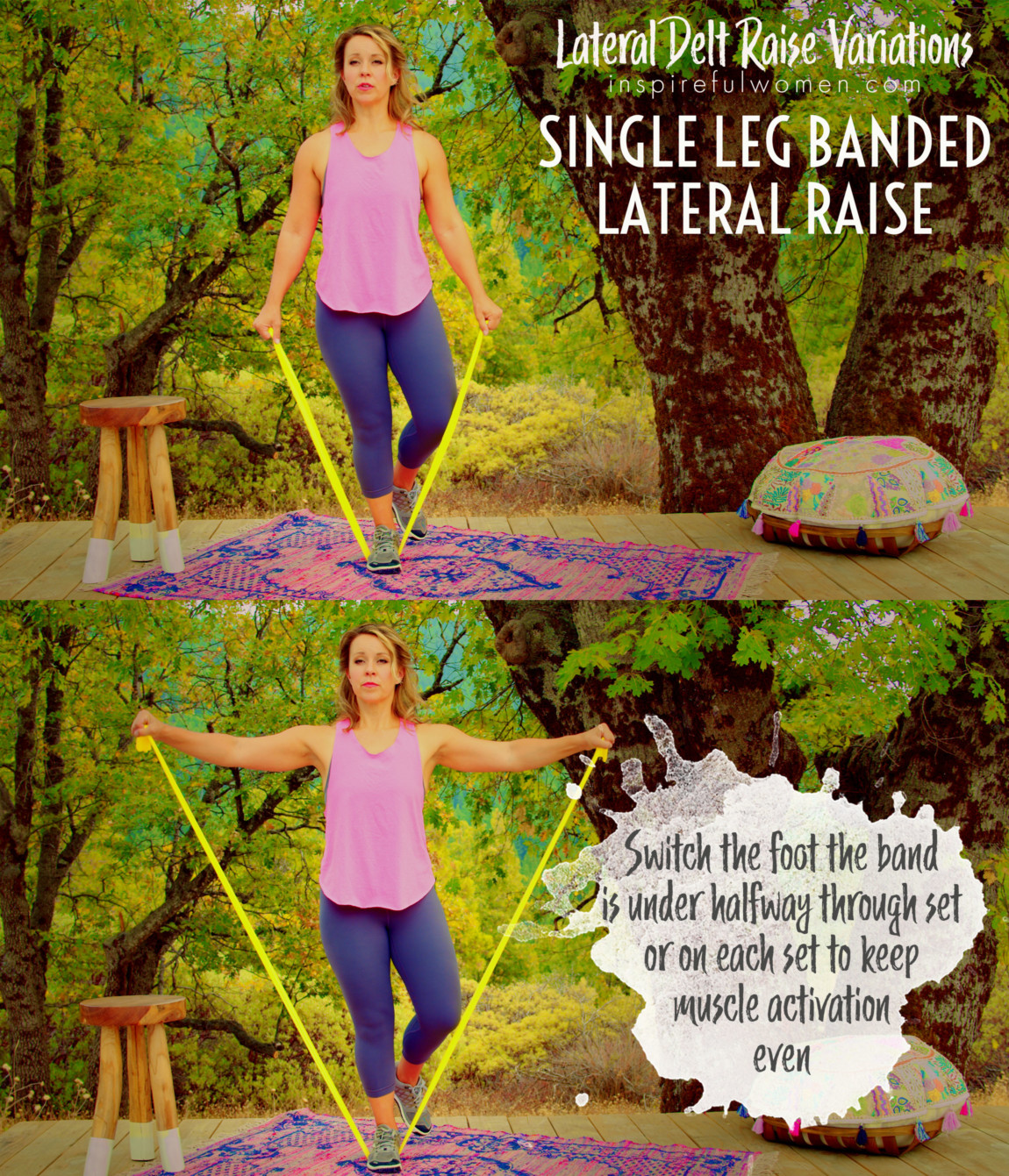
KNEE ON BENCH BANDED
Lateral Raise on Stool with Resistance Band
You can rest your knee on a stool, as long as the height allows your hips to be level, and stick the band under your knee to secure it.
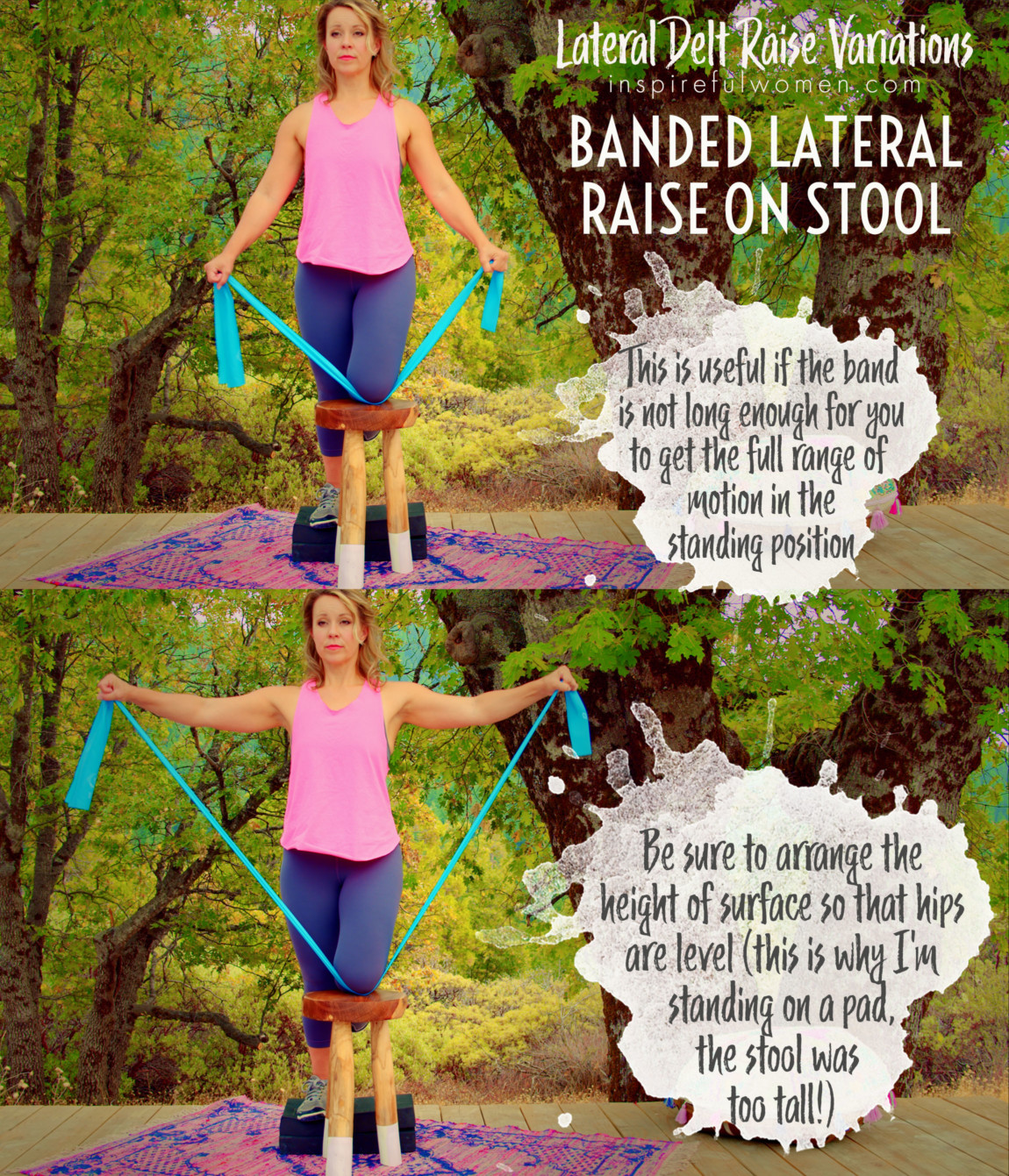
SEATED BANDED LATERAL RAISE
Seated with Resistance Band
A couple options:
Band Under Feet: Put feet further back and band under the heels so the pull is more in line with the sides of your body.
Band Under Seat of Chair: Another way to mount the band is to slid it under the seat of the stool or bench or chair you are sitting on it. It will be held in place by the bottom side of the seat.
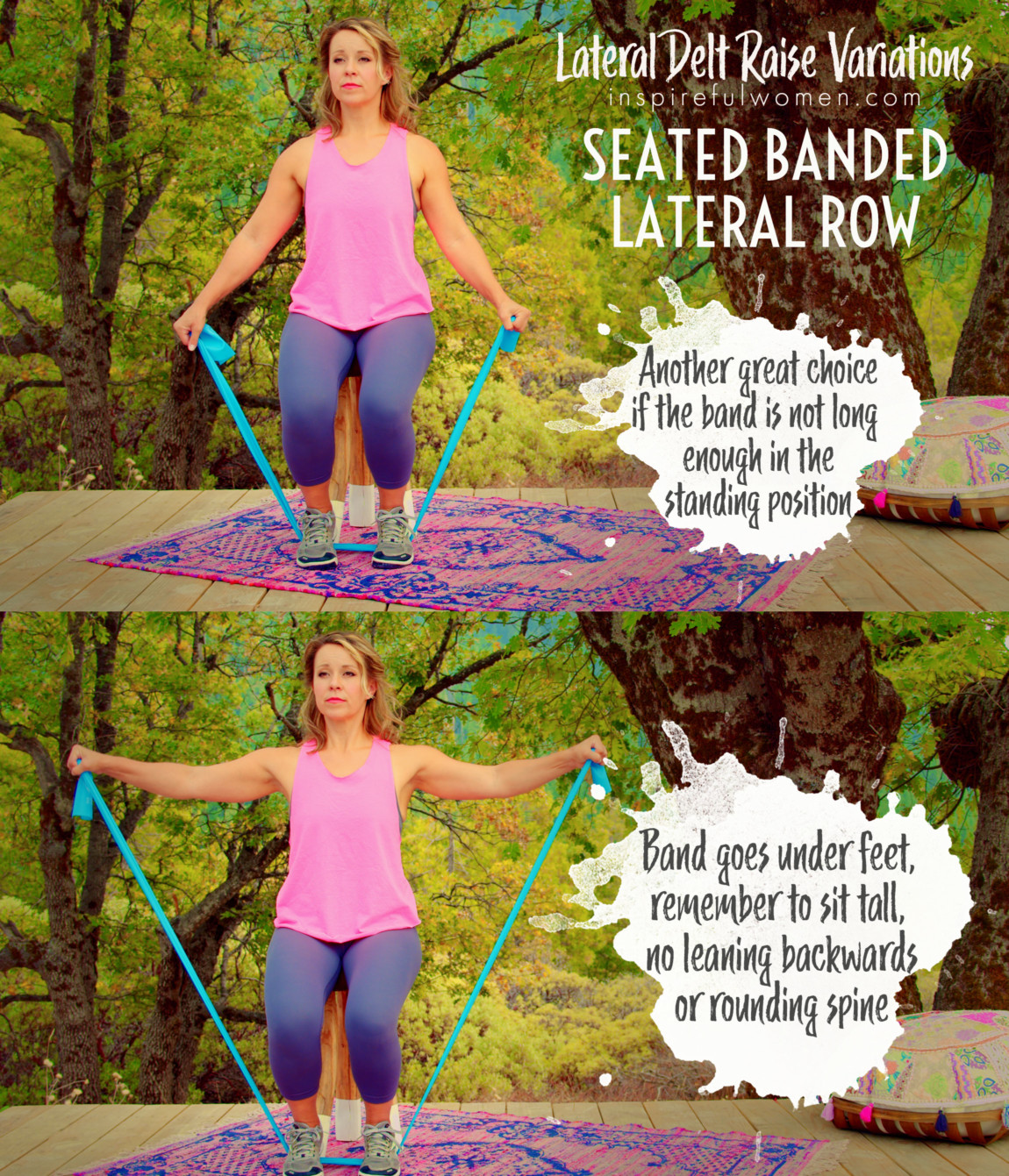
MAKE IT HARDER
HARDER
MAKING THE SIDE LATERAL DELT RAISES MORE CHALLENGING
SLOW ECCENTRIC
Slow on the Down
Increasing the time that your muscle is under tension during a rep will increase the muscle fatigue you experience from those reps. You can take a full 5-10 seconds to return to the start position for each rep.

HEAVIER WEIGHTS
Different Weights for 1 Set
Use a heavier weight for as many reps as you can do (may be only 3-6 reps), then immediately replace those with the lighter dumbbells and continue doing reps with no rest to finish the set. You can gradually increase your strength this way until you can do all the reps of a set with the heavier weight.
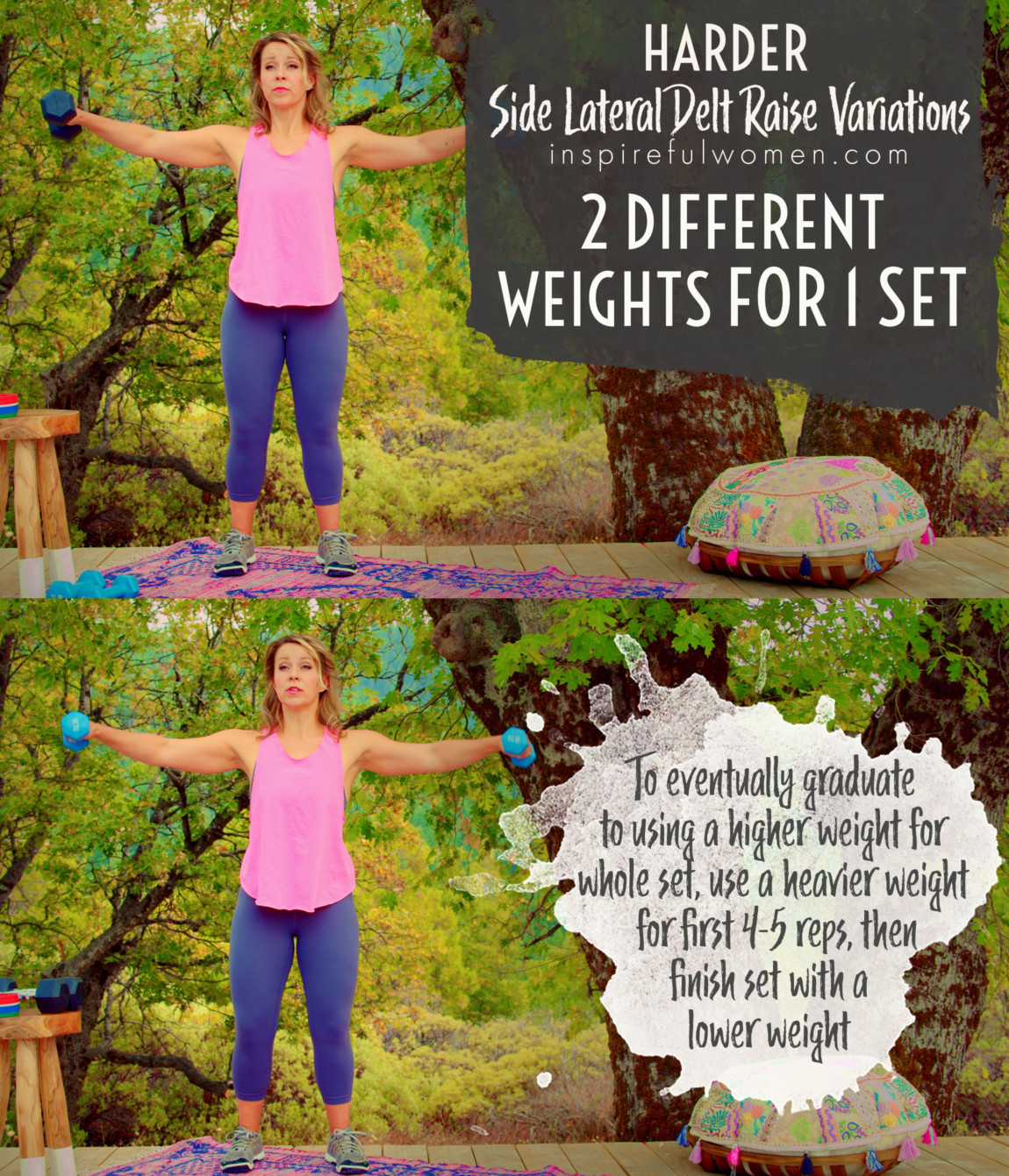
ADD MICRO PLATES
Add Fractional Plates
As long as the grip still feels comfortable, you can try holding a fractional plate in your hand along with the dumbbell. This can really help you graduate to higher weights - for many of us, we can't just move directly from 5 to 10 lb dumbbells, or even 5 to 8 lbs. It's just too big a jump for us ladies. This can be a way to bridge that gap.
Before I had built enough strength to do 10 and then 12 lb dumbbells for this movement, I would use 5 lbs dumbbells, adding a 1 lb fractional plate to my palm, so that each side was lifting 6 lbs.

PARTIAL REPS
Partial Reps
You don’t want partial reps to be the ONLY part of the movement you ever do, but these can be very very effective for helping to fatigue the muscle you are desiring to work. So what this means here is:
The main ROM (range of movement) for the lateral raise where the lateral deltoid is doing more of the work is in the top ⅔ of the movement. As your arms fall below 2/3rds, the last 1/3rd, one of the rotator cuff muscles the supraspinatus is more the mover. By doing some reps only in the top ⅔ of the range, you keep the tension on the lateral delt muscle the entire time, giving it less rest, and therefore it will fatigue faster. To do this, raise your arms to shoulder height, then lower only 2/3rd of the way before raising your arms back up again. You can do this:
- For an entire set
- For the first several reps of a set - ie do these partial 2/3rds ROM first, then without putting down the weights, as your shoulders begin to fatigue, switch to doing full range of movement reps.
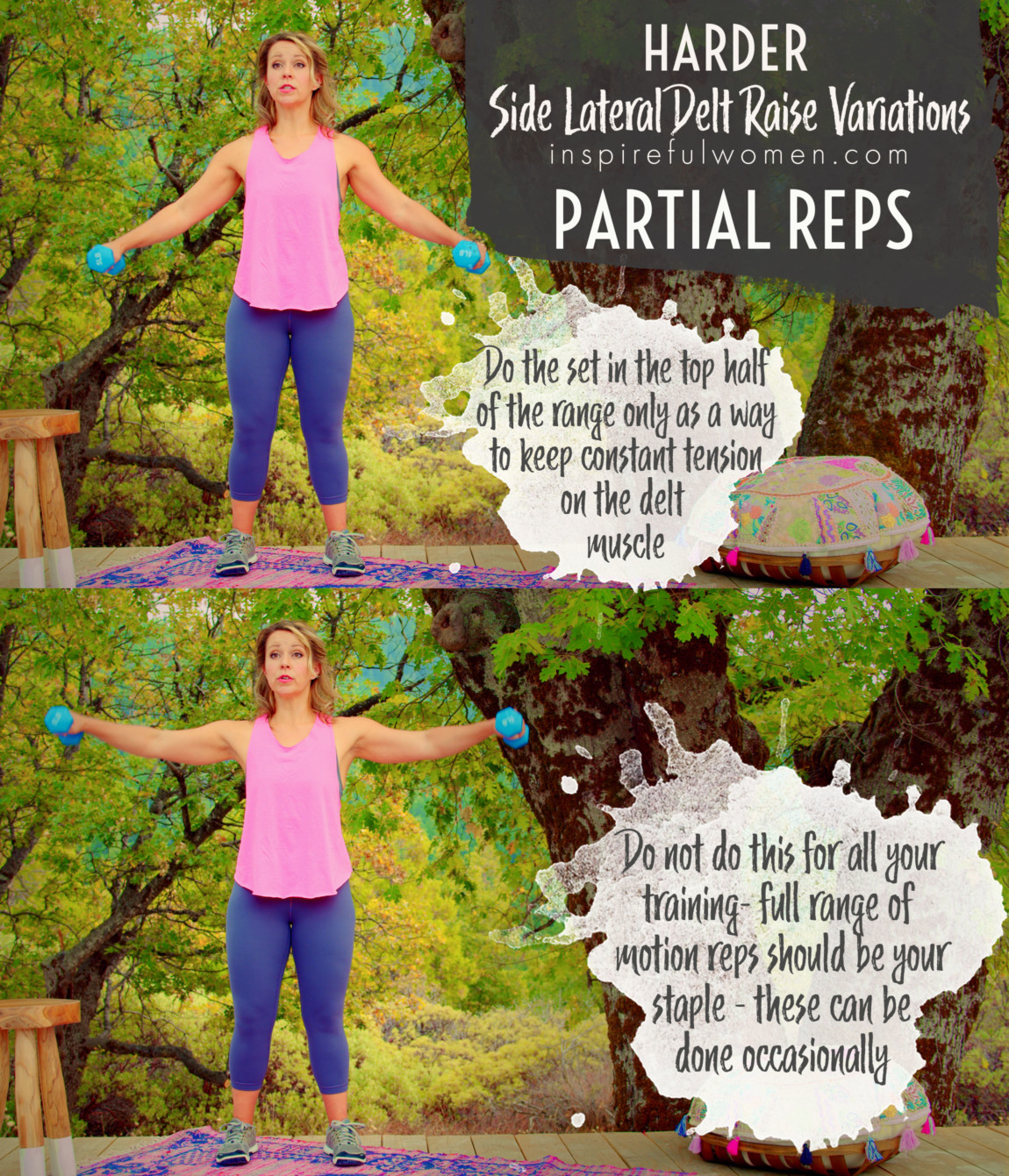
MAKE IT EASIER
EASIER
MAKE THE SIDE LATERAL DELT RAISES MORE DOABLE
BODYWEIGHT OR VERY LIGHT WEIGHTS
No Weights or Very Very Light Weights
Start with no resistance or use fractional plates.
You can also use food cans! Preferably a food you like. 😉 Like I don't know what it is but I really love canned peaches. Dunno why. I think it has something to do with the types of dinners my grandma used to make.
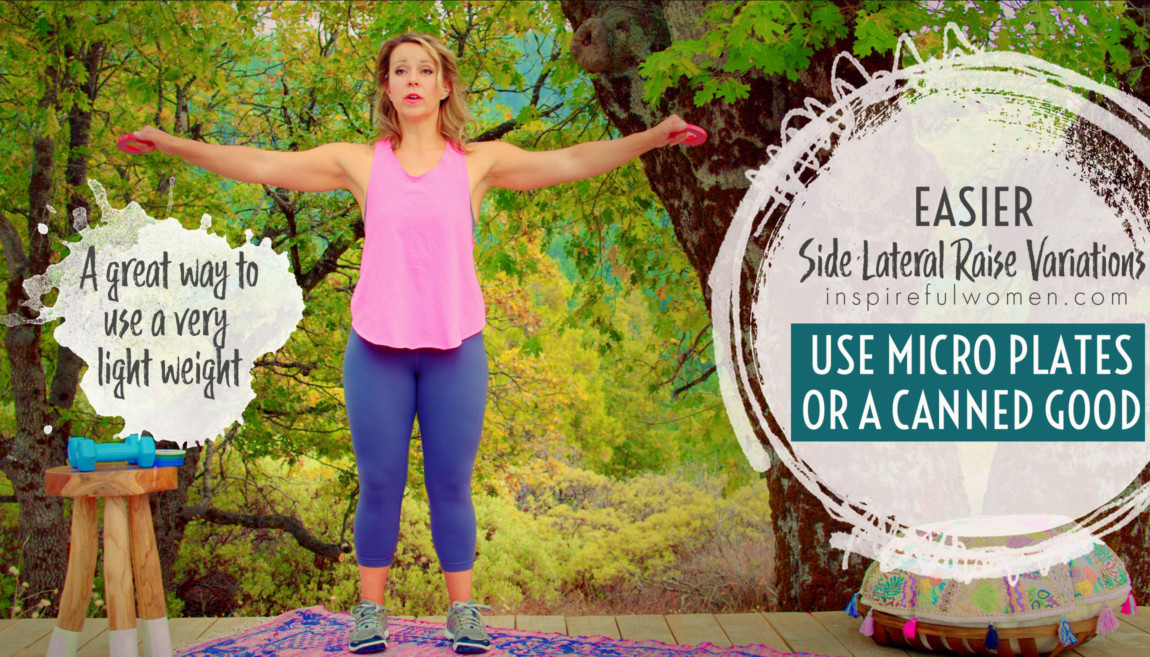
LATERAL RAISE ON STABILITY BALL
On Stability Ball w/ Dumbbells
Sitting on a stability ball will be less stable than standing, but more stable than seated on a chair. So some core activation but not too much. It's a great choice when you want/need to be seated.
Additionally being seated allows you to focus more on the actual movement itself- the lateral raise - and can help you recruit the right muscles more easily.
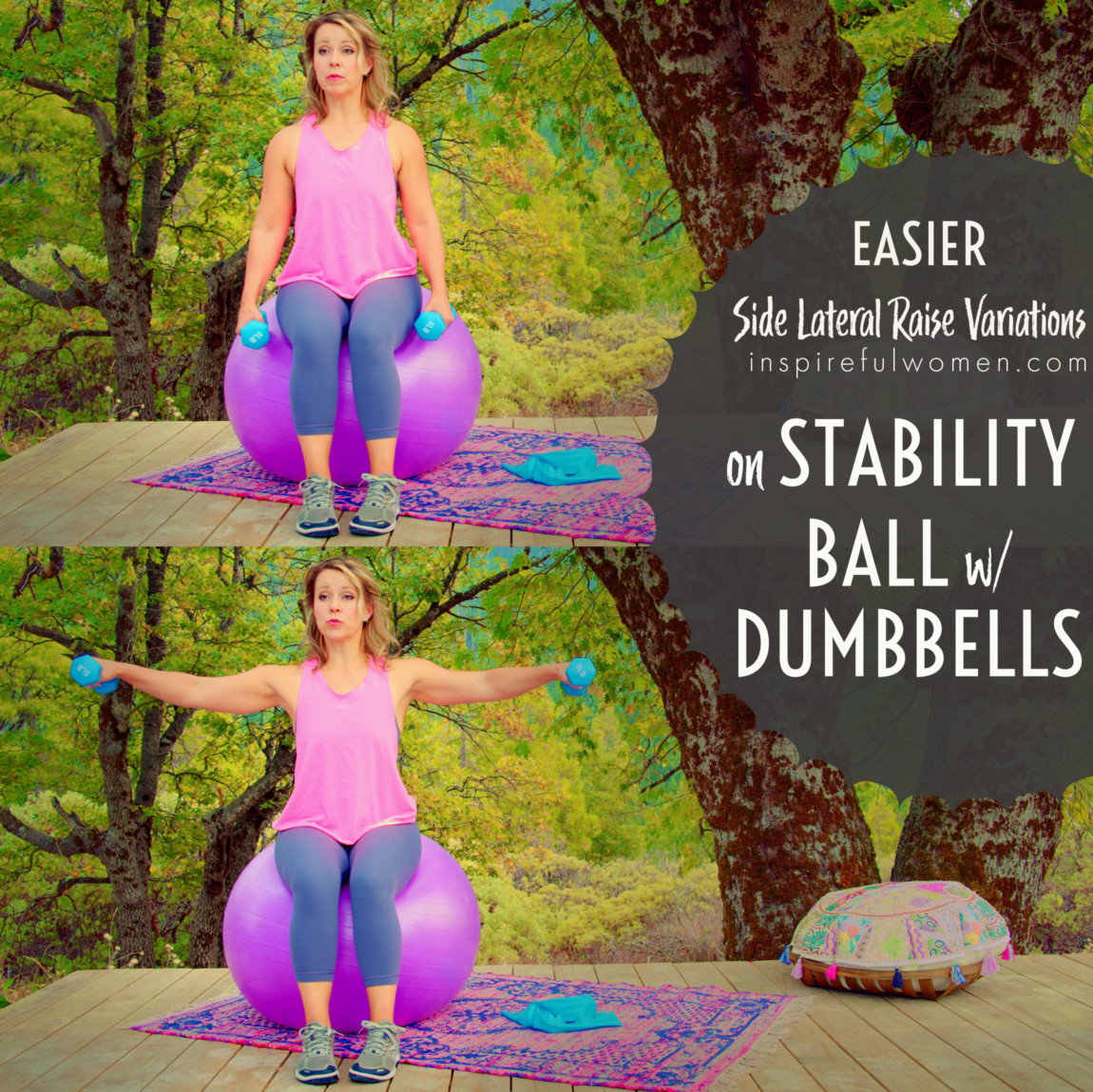
BANDED ON STABILITY BALL
On Stability Ball w/ Resistance Bands
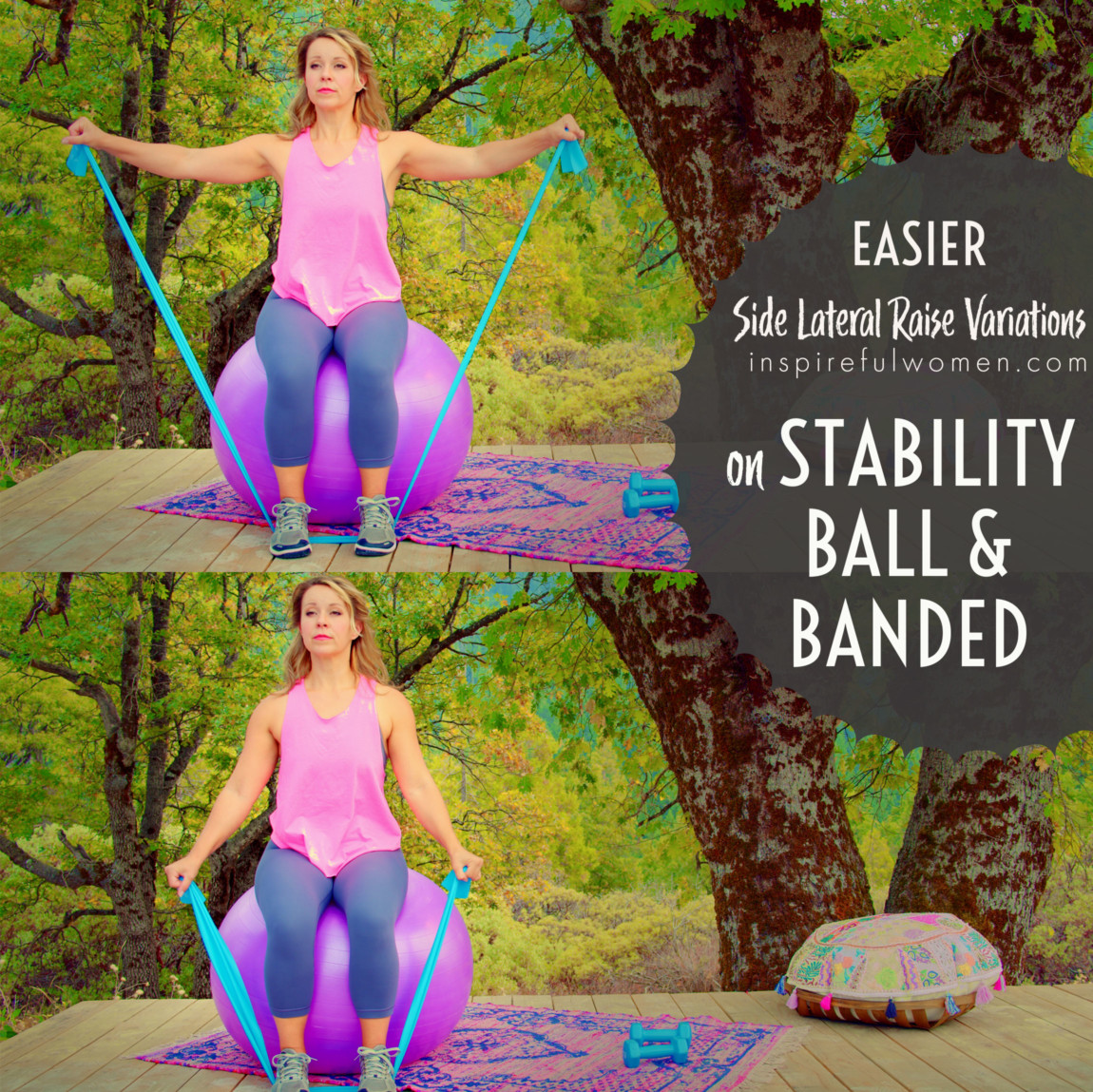
SCIENCY STUFF
SCIENCY STUFF
SPIFFILICIOUS FACTS ABOUT MUSCLES & MOVES
As we've discussed, the lateral deltoid muscle is what moves the arm away from the body out to the SIDE of you.
This is the movement that you would use to lift your arm out to put your arm into the sleeve of a coat, or lift and carry items out to the side, such as groceries, bucket, suitcase, or carrying a child on your hip. The lateral deltoid works with the supraspinatus (one of the rotator cuff muscles) to perform this movement. Although the primary function of the lateral deltoid is to lift the arm out to the side, if you lift an object that is too heavy for another portion of the deltoid to lift (regardless of where the arm is) the lateral deltoid will assist the other portions of the deltoid.
The three portions of the deltoid muscle all insert on the upper arm bone though one tendon. Anytime that one of the portions of the muscle is not strong enough to do its job, the other portions of the deltoid will help. If you use a heavy weight, The front of the delt (anterior) and posterior delt (rear) of the deltoid muscle are also active. The different portions of the deltoid can be targeted by changing the position of the arm relative to the body and also with rotation of the arm.
This lateral deltoid raise will also strengthen all of the rotator cuff muscles and the muscles that move the shoulder blade which contribute to good posture.
Another very important function of the lateral deltoid muscle is to hold the upper arm bone (humerus) in the socket of the shoulder joint. The shoulder joint is a very unstable ball and socket joint. The role of the muscles that stabilize the joint is to hold the ball or head of the upper arm bone (humerus) centered in the socket, when holding an object, and with movement of the arm. Gravity and the other rotator cuff muscles (all but the supraspinatus - teres minor, infraspinatus, and subscapularis) are positioned to move the head of the humerus down in the socket. The lateral deltoid (with assistance from the other portions - but it depends on exactly how the arm is being pulled down) contracts to hold the head of the upper arm bone (the humerus) up and centered in the socket. This is important for avoiding shoulder injuries of the rotator cuff muscles and preventing degenerative changes in the joint.
The way that these muscles act together to hold the ball in the socket is known as a force couple - the muscles each pulling in different directions to stabilize the joint. It is important that all portions of the deltoid and the rotator cuff are exercises in ways that will train the muscles to stabilize the joint.
ALLLL MUSCLES & WHEN
ALL MUSCLES WORKING & WHEN DURING THE STANDING LATERAL DELT RAISE
The top 2/3rd of the movement targets the lateral (middle) deltoid, and the bottom 1/3rd of the movement targets one of the rotator cuff muscles called the Supraspinatus.
PIN IT FOR LATER!
